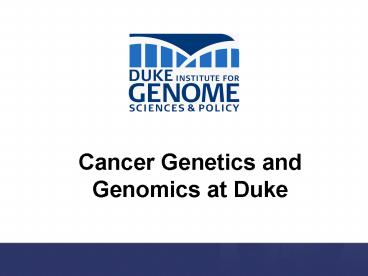Cancer Genetics and Genomics at Duke - PowerPoint PPT Presentation
1 / 34
Title: Cancer Genetics and Genomics at Duke
1
Cancer Genetics and Genomics at Duke
2
Cancer Genetics and Genomics Program
- Cancer Genetics, with a focus on the
identification of genes that define risk of onset - Cancer Genomics, with a focus on applying
molecular profiling technologies to explore
cancer phenotypes and outcomes - Oncogenic Mechanisms and Pathways, with a focus
on genes and activities known to participate in
the oncogenic process
3
Cancer Genetics and Genomics Program
- Program Activities
- Total of 25 members from 8 Departments
- Integrative Cancer Biology Program (NCI P50
center) - Weekly Cancer Genomics Conference
4
Cancer Genetics and Genomics Program
http//people.genome.duke.edu/nevin001/Meetings/C
ancerGenomics/
5
Application of Genomics to Cancer
- Improve the care of patients through the
development of genomic tools for - Individualized prognosis and treatment
- A genomic roadmap for guiding the use of
therapeutics
6
Genomic Prognosis
Anil Potti Mike West John Olson Jeff Marks Kelly
Marcom David Harpole Holly Dressman Geoff
Ginsburg Joe Nevins
7
Genomic Prognosis
- Improved prognosis with clinico-genomic
predictive models
Use to refine clinical prognosis
8
An Opportunity in Lung Cancer
Early Stage NSCLC Treatment Protocol
lt3cm
Stage 1a Observation
gt3cm
Stage 1b Adjuvant Therapy
Diagnosis
Tumor is resected and measured
- As a population, Stage 1a patients do not show a
benefit from chemotherapy - Yet, 25 of Stage 1a patients will relapse and
die
9
Genomic Tumor Profiling
Low Risk High Risk
Genes
Tumor Samples
- Gene expression profiles from set of Stage I
III Duke NSCLC tumors - Development of predictive model for recurrence
10
The Duke Metagene Lung Predictor
- Predictive accuracy of over 90 - far exceeds
clinical prognostics - Model valid across each clinical stage and
histological subtype
11
Validation of Duke Metagene Lung Predictor
- Validated in a blinded, multi-institutional study
of - 84 NSCLC patients
12
Improved Prognosis in Stage 1a NSCLC
Approved and endorsed by CALGB Executive
Committee - Nov 2005
13
What Next?
After prognosis, how to select the best therapy?
14
Chemo Response Signatures
Anil Potti Holly Dressman Geoff Ginsburg John
Lancaster Mike Kelley Phil Febbo Joe Nevins
15
Signatures of Chemotherapy Response
NCI-60 Cancer CellLine Panel
Chemotherapy response data Affymetrix data
Docetaxel
Adriamycin Etoposide
5-FU
Paclitaxel
Cytoxan
16
Predicting Patient Response to Chemotherapy
Prediction of docetaxel response
Breast cancer
Ovarian cancer
17
Predicting Patient Response to Chemotherapy
Prediction of topotecan response
Prediction of taxol response
18
Predicting Patient Response to Chemotherapy
19
An Opportunity to Guide Therapy Tomorrow
Usual Care
Outcome
Diagnosis
Randomize
Genomics-Guided Care
20
An Opportunity to Guide Therapy Tomorrow
AC or Taxol
Outcome
Breast Cancer Patient
Randomize
Genomics-Guided AC or Taxol
A C Tax
21
Opportunities for Resistant Patients
- How to match complexity of disease with
treatment? - Recognition of role of pathway deregulation in
cancer phenotypes
22
Pathway Signatures
Andrea Bild Holly Dressman Erich Huang Penni
Black Joe Nevins
23
Duke Innovation - The Duke Pathway Predictor
- Patterns that profile pathway status in tumors
- Patterns that link pathway status with drug
response
24
Applying the Duke Pathway Predictor
- Pathway signatures provide mechanism to detect
pathway deregulation in tumors - Patterns of pathway deregulation identify
clinically-distinct sub-groups of patients
25
Using the Duke Pathway Predictor to Guide Therapy
Pathway prediction
A guide to therapeutic selection?
26
Matching Pathways With Therapeutics
Herceptin
FTI
SU6656
Int-H1-S6A
Roscovitine
LY294002
BAY43-9006
PD98059
27
Pathway Deregulation in Cancer Cell Lines
Ras Myc
E2F Src
b-Cat
28
Predicting Therapeutic Response
Ras Ras
Src
Predicted Src Activity
- Pathway signatures as measured on 19 established
breast cancer cell lines predicted response to
targeted inhibitors - Conversely, no correlation of response with
non-targeted pathway deregulation
29
Implications
- Oncogenic Pathway Profiling
- A unique approach to guiding the use of targeted
therapeutic agents - No other mechanism today for defining the future
of combinational therapy - Major opportunities for partnerships with Pharma
to facilitate the next phase of clinical trial
development
30
The Case for Trial Enrichment - Herceptin
- Savings in clinical trial costs 35 million
- Income from 8 year acceleration of product 2.5
billion - Access to drug from acceleration 120,000
patients
31
Implications
- Oncogenic Pathway Profiling
- Perhaps the most important opportunity for
application is in the area of combinational
therapy - Two major challenges -
- How to select the proper combinations
- How to select the patients who could benefit from
unique combinations
32
A Roadmap to Pathway Deregulation in Tumors
- A guide for identifying potential combinations of
therapeutics - A guide for selecting patient populations for
next generation of combination therapy trials
33
In Integrated Approach to Personalized Treatment
Improved Prognosis
Prediction of therapeutic response
34
Cancer Genetics and Genomics Program
- Cancer Genetics, with a focus on the
identification of genes that define risk of onset - Cancer Genomics, with a focus on applying
molecular profiling technologies to explore
cancer phenotypes and outcomes - Oncogenic Mechanisms and Pathways, with a focus
on genes and activities known to participate in
the oncogenic process































